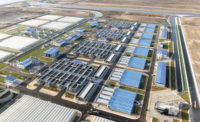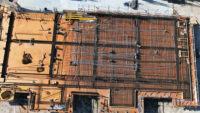San Wai Sewage Treatment Works – Phase 1
Hong Kong Special Administration Region, China
BEST PROJECT, Water/Wastewater
Submitted By: China Harbour Engineering Co.
Owner: Drainage Service Department, HKSAR
General Contractor: ATAL - DGT - CHEC Joint Venture
Project Manager: AECOM
The joint venture team of ATAL Environmental Engineering, Degremont and China Harbour Engineering more than doubled the size of the San Wai Sewage Treatment Plant in a rural area just outside of Hong Kong to accommodate the city’s expanding development.
The scope of work for the $400-million design-build-operate venture included designing and building new treatment facilities capable of processing nearly 500,000 cu meters per day at the existing 164,000 cu/md day plant with ultraviolet disinfection before discharge through an existing tunnel to Deep Bay, 30 km outside of the city. Work on the project began in May 2016 and wrapped up in March 2021.
Because the design and construction team was working with an existing plant, studying and understanding the rate of hydraulic flows in and out of the facility was key to keeping costs competitive, according to Kenny Cheung, China Harbour Engineering project and construction manager.
The team used the power of gravity in developing the hydraulic design to lower energy consumption and costs and to work within the parameters of the existing structures on the site, Cheung says. Ove Arup & Partners, Ltd., Hong Kong, served as consultant for computational fluid dynamics flow analysis and hydraulic design.
“We worked with designers, the trades and the operator closely to work out the best plant layout under the site constraints and hydraulic flow and operation requirements,” Cheung says.
The project also includes other green features, such as solar panels on top of some of the buildings.
Because the site was too small to fit the amount of capacity needed, the project team used a chemical-enhanced process train developed by France-based firm Degremont that integrates in one structure coagulation, flocculation and sedimentation process trains.
The project construction crew used an open-cut method during excavation rather than tunnel boring to relieve congestion in the work area and to improve worker safety, Cheung notes.





